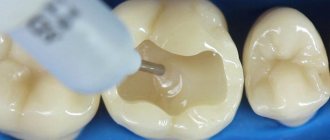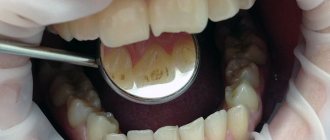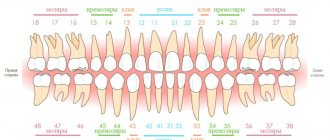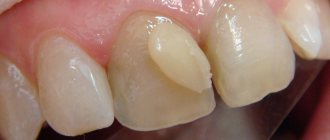Tooth filling is one of the most common and well-established dental procedures, however, it also has its own nuances and subtleties. We tell you what you should pay attention to, what filling to choose and how the filling is installed on a tooth at the ViDentis clinic.
Almost every person has had to deal with a tooth filling in their life. This is a simple and effective procedure, which consists of removing damaged areas of enamel and its further restoration using special compounds. The cost of installing a filling is low, so this treatment is used quite often.
Installing a filling on a tooth: indications
It is recommended to put a filling in dentistry mainly for caries. This is a pathological process that consists of the slow, gradual destruction of tooth tissue under the influence of bacteria contained in soft plaque. As a result of their vital activity, these bacteria produce acids that destroy calcium in tooth enamel. The enamel becomes fragile and is destroyed, forming carious cavities, which, without proper treatment, gradually increase more and more.
By installing a filling on a tooth, you can restore a crown that has been destroyed by caries by about a third. If the tooth tissues are more damaged, then other methods of their restoration are used.
However, caries is not the only reason to get a filling in dentistry. Filling can also correct:
- cracks and chips of enamel;
- traumatic injuries;
- erased enamel (with bruxism).
Is it possible to install a temporary filling yourself?
The installation of fillings should only be entrusted to a doctor. The fact is that, for all its rigidity, the tooth is very easily susceptible to infection. If you close a cavity in a tooth without proper preparation, there is a high probability of infection and the development of serious complications. The simplest thing is inflammation of the pulp, or pulpitis. In serious cases, the patient may lose a tooth and even harm neighboring ones if the inflammation spreads.
The desire to fill a tooth with temporary material may arise if a permanent or temporary filling falls out or a piece of the crown part of the tooth breaks off. In these cases, you need to make an appointment with a doctor as soon as possible, and while waiting for the visit, avoid getting food into the resulting cavity and follow simple rules.
What types of fillings are there?
There are several types of filling materials. The type of material determines the cost of installing a filling on a tooth, how long it will last, and how good it will look.
- Cement fillings have been popular for some time now due to their low cost and ease of use. The main disadvantage of dental cement is its short service life (up to 2 years), as well as its adverse effect on tooth tissue (they can gradually collapse around the filling).
- Plastic fillings are another simple and cheap way to restore a tooth. However, plastic changes color over time and shrinks greatly, ceasing to perform protective functions.
- Composite fillings are the best inexpensive filling option. They have acceptable aesthetics and can last up to 3-5 years.
- Light-curing fillings are one of the most modern and technologically advanced filling methods: the polymer hardens in the light of an ultraviolet lamp. You can quite accurately match the color of the filling to the color of the enamel and make it almost invisible. Yes, these fillings have the highest price, but putting a filling made of photopolymer means solving the issue of restoring a tooth for 5 years or more.
At the ViDentis clinic, patients are offered high-quality light-curing fillings made in America, Japan and Germany.
What is filling?
What is filling? Filling is a way to restore the shape and function of a tooth destroyed by caries. When a dentist fills a tooth, he first removes decayed tooth structure, cleans out the infected area, and then fills the cleaned cavity with filling material.
By sealing off areas where bacteria could enter, fillings also help prevent further tooth decay. Materials used for fillings include gold, porcelain, composite materials (tooth-colored fillings) and amalgam (an alloy of mercury, silver, copper, tin and sometimes zinc).
Which type of filling is better? There is no type of filling that is perfect for everyone. The option that's right for you may depend on how much restoration is needed, whether you are allergic to certain materials, what area of your mouth needs filling, and the cost of the dentist. The selection of different materials includes the following types:
- Gold fillings are made in a laboratory and then placed in place. Gold inlays are well tolerated by the gum tissue and can last over 20 years. For these reasons, many renowned experts consider gold to be the best filling material. However, gold fillings are often more expensive than others and require multiple appointments.
- Amalgam fillings are resistant to wear and tear and are relatively inexpensive. However, due to their dark color, they are more noticeable than porcelain or composite fillings, and they are not usually placed on prominent areas such as the front teeth.
- Composite material is matched to the color of the teeth and is therefore used where a natural appearance of teeth is desired. The components are mixed and placed directly into the tooth cavity, where they harden. Composites may not be the best materials for large fillings because they can chip or wear out over time. They can also be stained by coffee, tea, or tobacco, and do not last as long as other types of fillings—3 to 10 years in general.
- Porcelain fillings are called inlays and are made in a dental laboratory and then bonded to the tooth. They are stain resistant and can be matched to the color of the tooth. A porcelain restoration usually covers most of the tooth. It costs about the same as gold.
If decay or a crack has damaged most of the tooth, you can get a crown. If the decay has reached the nerve, then there are 2 treatment options - either a root canal treatment (if the nerve is damaged, it is removed) or a protective coating of the dental pulp (to keep the nerve alive).
How is a filling placed? If your dentist decides to fill a cavity, he will first remove the decayed tissue and clean the affected area. Then the cleaned cavity will be filled with one of the materials discussed above.
How do I know if I need a filling? Only your dentist can determine if you have a cavity that needs to be filled. During the examination, your dentist will examine the surface of each tooth using a special dental mirror.
Then, areas that raise doubts are carefully examined using special instruments. Your dentist may also take x-rays of your entire mouth or a specific area of your mouth. The type of treatment your dentist chooses will depend on the number of cavities.
| Malgama | Gold filling |
| Composite |
How does the filling installation process work?
Filling is carried out in several stages.
- Examination and assessment of the condition of the tooth. The doctor determines the size of the lesion and finds out whether the inflammation has spread to the pulp.
- Anesthesia. Tooth filling is carried out under local anesthesia: one or two injections freeze the gum around the diseased tooth and the patient does not feel pain during further manipulations.
- Tooth preparation. The doctor drills the tooth, removing the affected tissue. At the ViDentis clinic, specialists work in binoculars - special microscope glasses in which the smallest details are visible. This allows you to preserve healthy tissue as much as possible, drilling only the areas affected by caries.
- Application of filling material. We use a layer-by-layer technique of applying polymer to the tooth and drying each layer with ultraviolet light. This allows you to achieve high strength and excellent appearance. Aesthetic restoration is also carried out in the same way, when, with the help of filling, for example, a chipped cutting edge of the front teeth is restored. This is the most reliable way to place a filling, and the cost of treatment does not increase.
- Turning and polishing of the filling. To ensure that the filling feels comfortable in the mouth, the doctor grinds off excess material, and so that plaque does not “get stuck” on the surface of the filling, it is polished.
For what dental diseases is filling used?
Tooth enamel is the hardest tissue in the body and can withstand loads of up to 400 kg. However, insufficient oral hygiene, consumption of excessive amounts of sweets, smoking, coffee, as well as genetic predisposition can lead to destruction of the integrity of the enamel. This process is called caries.
Depending on the depth of the lesion, caries can be:
- Initial caries - when there is no damage to the tooth enamel, except for a matte white spot. The reason for its appearance is the loss of minerals: calcium and fluoride. In this regard, the permeability of the enamel increases, so the color of the stain may change over time to dark brown and even black.
- Superficial caries is a stage that is already characterized by physical damage to the enamel, but only within its limits.
- Medium caries - characterized by deeper damage to tooth tissue. The destruction extends beyond the enamel and reaches the dentin zone.
- Deep caries is the most complex form of destruction of hard tooth tissues. The affected area reaches the area close to the pulp (nerve). At this stage there is a high risk of infection and inflammation.
Most often, caries develops in areas that are most difficult to clean. As a rule, these are interdental spaces and natural depressions in the tooth (fissures). Since there is practically no pain, and there are no significant visible changes, for a long time a person does not suspect the presence of caries. During this time, caries can go through all stages and by the time you contact a doctor, a significant part of the tooth will already be destroyed.
To prevent this from happening, it is necessary to undergo preventive examinations with a dentist every six months.
Advantages of direct restoration
In dentistry, as in any branch of medicine, the search for innovative, increasingly effective ways of working that would allow solving any, even the most complex and atypical problems, is of great importance. Direct restorations in modern dentistry, thanks to the use of new highly aesthetic and durable materials, have many advantages. But at the same time they are not without their drawbacks.
Advantages of filling:
- minimal intervention, the ability to keep the tooth alive and extend its service life;
- quick tooth restoration (restoration is carried out directly in the patient’s mouth during one visit to the dentist);
- safety, hypoallergenic, aesthetics, excellent adhesion and strength of modern materials for direct restoration;
- all processes of tooth treatment and restoration are controlled by one specialist, which eliminates errors when transmitting information about the external characteristics of the restoration to the dental technician;
- the ability to choose a shade of material that perfectly matches the color of the patient’s natural teeth;
- The quality of filling does not depend on the presence/absence of the clinic’s own dental laboratory and its equipment.
Even a large filling in a tooth can preserve its vitality, since when filling teeth, the dentogingival attachment, natural contact and exchange of substances between tooth tissues and oral fluid (saliva) are preserved.
Flaws:
- the likelihood of shrinkage of the composite over time;
- less accurate repetition of occlusal surfaces than in the manufacture of crowns;
- the risk of a decrease in the quality of the restoration due to errors/violations of technology - contact of the material with moisture, blood;
- human factor - working with composite materials requires attention, fast and precise actions from the doctor.
Only an experienced doctor can correctly assess the condition of the patient’s tooth and determine the optimal option for its restoration; select the best material. And from the point of view of a specialist, a good restoration is, first of all, a high-quality restoration, performed in compliance with technology and allowing to extend the life cycle of the tooth for many more years.
Advantages of dental fillings at Amel Dental
A highly professional staff of specialists, high-quality materials from leading manufacturers known throughout the world for their unique developments, modern high-tech equipment in dental offices are the main components of the work of the Amel Dental clinic, which allow us to provide patients with service at the level of world standards.
In addition, Amel Dental unites all areas of modern dentistry and offers a full range of dental services - from precise digital diagnostics to prosthetics. Thus, we have the resources to provide full qualified care to patients with any diseases, pathologies of teeth and gums.
Questions and answers
Should you endure the discomfort from a new filling or go to the doctor?
This question worries patients when they experience pain, a feeling of fullness and an “extra” protruding part of the filling. Complaints can arise for various reasons: displacement of parts (for example, an insulating gasket), shrinkage, formation of an overhanging edge, etc., and there may also be damage to the pulp or insufficient polymerization. If you experience any such sensations, you should contact your dentist.
Maybe it will all go away with time?
You shouldn't hope that everything will go away on its own. If discomfort occurs, you should contact a dental clinic as soon as possible to identify the source of the problem and eliminate it.
What to do if the filling falls out? [2,3]
Loss immediately or some time after installation may be associated with errors in tooth preparation, incorrect selection of filling material and its volume, or violation of individual stages of filling formation. This is a good reason to visit the dentist. It is impossible to keep the tooth cavity open, as this is fraught with food getting inside and the development of inflammation, activation of the carious process, destruction and loss of the tooth.
Can the filling be removed? [2,3]
If the filling shows signs of poor attachment (wobbles, has changed color at the edges, there is a feeling of air or water getting under it), then it is likely that it must be removed. But sometimes such sensations accompany a temporary filling with medicine, and this is not a sign of its failure. To remove it (including if it is no longer aesthetically pleasing), you must consult a doctor.
Medical expert: Oleg Sergeevich Shchekin
Last updated: July 21, 2021
Anesthesia and sedation in dentistry
Pain in the teeth and trigeminal nerve system is a dangerous condition for the patient. In severe cases, shock may develop. Therefore, in the overwhelming majority of cases, during filling, anesthesia is performed, and in case of complex diagnoses, drug sedation is used. General anesthesia is not used, as it requires the administration of specialized drugs, the presence of an anesthesiologist-resuscitator, and intubation of the patient.
Types of pain relief:
- Application anesthesia - applying bandages with anesthetic, using a spray with lidocaine. Most often used in the treatment and removal of baby teeth.
- Infiltration - the doctor injects an anesthetic into the mucous membrane, periosteum. The drug blocks the transmission of pain impulses along the nerve.
- Conductive – indicated for the treatment of molars, gum surgery, and volumetric interventions. The drug is injected into the branching zone of the trigeminal nerve. This type of anesthesia is performed mainly in a hospital setting.
Application, infiltration and conduction anesthesia
Sedation is used to put the patient into a light sleep and physical relaxation. During treatment, the presence of an anesthesiologist is indicated. But after the procedures are completed, the patient quickly comes to his senses and can return to his normal life. Further observation by a resuscitator is not required.
There are inhalation and injection methods of administering sedatives. The method is chosen by the doctor, it depends on the patient’s diagnosis - both dental and general (hyperactive child, children with cerebral palsy and autism, it is necessary to carry out extensive intervention in a minimum number of visits).
Restoring a “dead” tooth with a crown
If more than 50% of a part of a tooth is destroyed by the crown, it is not recommended to restore the lost part with a filling and the dentist will suggest installing a crown. Why does the volume of the part being restored influence the choice of a crown?
Over time, the composite material from which the filling is made gives vertical and horizontal shrinkage, as a result of which the connection of the antagonist teeth into the bite and the distance between adjacent teeth changes.
What problems does shrinkage of the filling lead to are described in detail in the article Why change an old filling if everything is fine and the tooth is not bothering you?
Here we will give just one example: shrinkage of the filling can lead to an increase in the load on the walls of the tooth, which over time will cause them to chip. If the crack goes under the gum (root crack), all that remains is to remove the tooth, and its restoration will require the installation of an implant or prosthetics with support on the adjacent teeth.
Unlike a filling, which is made by a dentist in one oral visit, a crown is made from impressions in a dental laboratory, so it better recreates the anatomical shape and color of the tooth. A crown is stronger than a filling and protects the tooth well from further destruction. When installing a crown, only a small layer of cement with which it is glued shrinks.
Most often, orthopedic dentists offer crowns made of metal ceramics or zirconium dioxide. We talk about choosing crowns in the article How does an orthopedic dentist decide which crown is right for your case?
The crown will last 10–15 years, but may require replacement, most likely for aesthetic reasons: receding gums lead to exposure of the edge of the crown. The edge of the metal-ceramic crown is especially noticeable on teeth in the “smile zone” (the first 5–6 teeth on each side).










